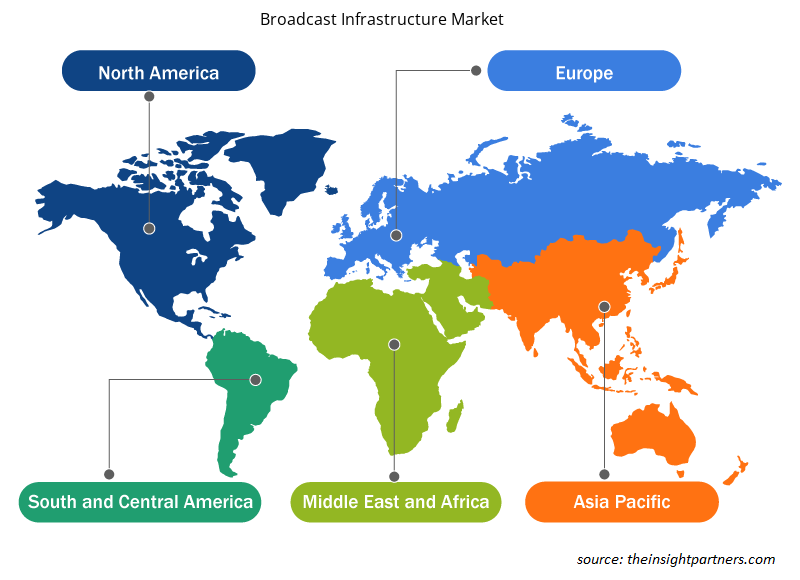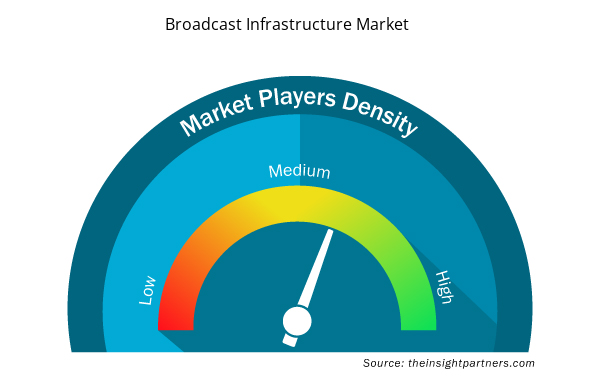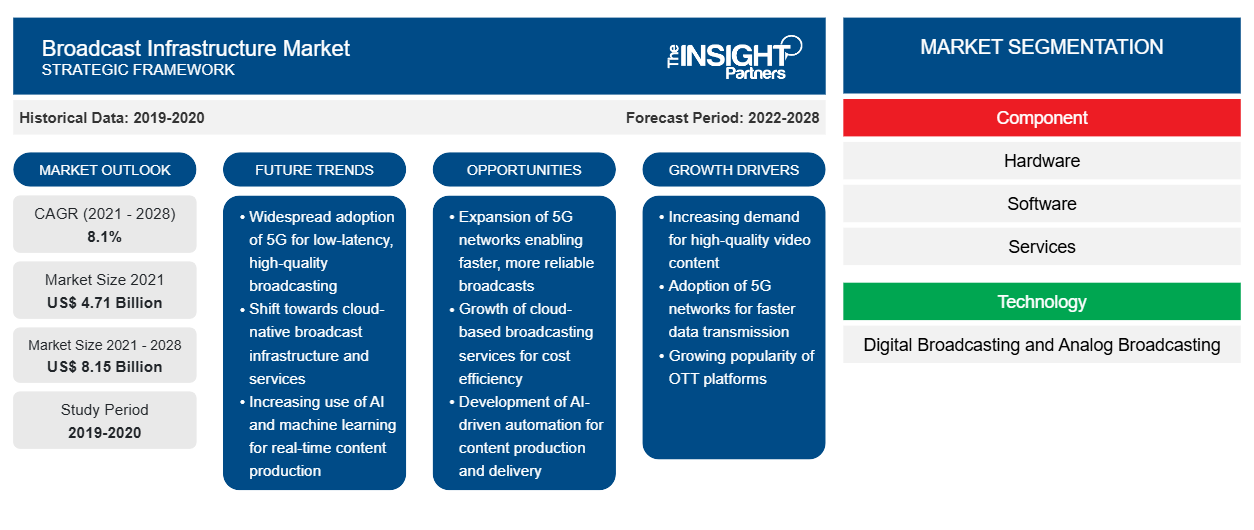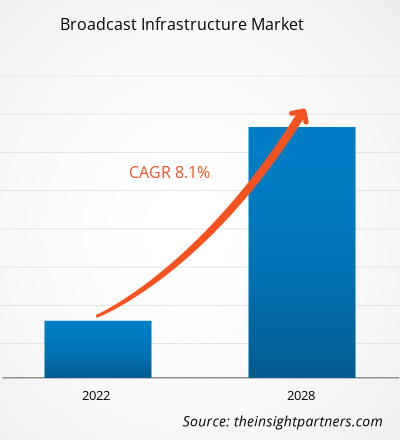[Informe de investigación] El mercado de infraestructura de transmisión se valoró en US$ 4.713,7 millones en 2021 y se proyecta que alcance los US$ 8.145,7 millones en 2028; se espera que crezca a una CAGR del 8,1% entre 2021 y 2028.
El cambio de paradigma de la industria de la radiodifusión, de la tecnología analógica a la digital, ha introducido una infraestructura de transmisión avanzada, que es relativamente compleja. La industria de la radiodifusión está siendo testigo de una demanda significativa de nuevas tecnologías de transmisión, como la televisión por protocolo de Internet (IPTV), la televisión web, la televisión de alta definición (HDTV) y el pago por visión. Se espera que la demanda de experiencias de video enriquecidas allane el camino para las emisoras de todo el mundo, especialmente en Asia. Otro factor clave que impulsa el mercado de la infraestructura de transmisión son las plataformas integradas que consisten en servidores, decodificadores y sistemas de protección de contenido de video, junto con las herramientas adecuadas, el middleware y la facturación, lo que permite la prestación de una variedad de servicios de televisión en varios formatos, como video a pedido, transmisión y televisión diferida, basados en una combinación de redes IP subyacentes y sistemas de acceso óptico o DSL. Hoy en día, los proveedores están pasando de la infraestructura basada en hardware a la infraestructura basada en software debido al alto costo de la infraestructura de hardware de transmisión, el alto costo de mantenimiento y las frecuentes actualizaciones de hardware. La industria de la radiodifusión ha estado experimentando innovaciones revolucionarias con desarrollos tecnológicos para brindar una mejor experiencia a los usuarios y crear una oportunidad para los proveedores de infraestructura de radiodifusión.
Personalice este informe según sus necesidades
Obtendrá personalización en cualquier informe, sin cargo, incluidas partes de este informe o análisis a nivel de país, paquete de datos de Excel, así como también grandes ofertas y descuentos para empresas emergentes y universidades.
- Obtenga las principales tendencias clave del mercado de este informe.Esta muestra GRATUITA incluirá análisis de datos, desde tendencias del mercado hasta estimaciones y pronósticos.
Impacto de la pandemia de COVID-19 en el mercado de infraestructura de transmisión
En la pandemia de COVID-19, una gran cantidad de personas trabajan desde casa y pasan más tiempo en línea, lo que hace que se muestren orgullosos de su transición a lo digital. Esta demanda de recursos digitales está presionando aún más los sistemas de varias organizaciones de software y plataformas y obstaculizando su capacidad para brindar servicios con confiabilidad y calidad. Sin embargo, el brote de COVID-19 ha afectado negativamente a los actores que participan en la entrega de contenido de video para los usuarios finales, debido al cierre de las empresas y la escasez de mano de obra. La crisis de COVID-19 también ha alterado drásticamente las operaciones en toda la cadena de valor, desde las redes de proveedores hasta la experiencia de entrega al cliente debido a los cierres de empresas, las prohibiciones de viaje y las interrupciones de la cadena de suministro.
Perspectivas de mercado: mercado de infraestructura de transmisión
Creciente adopción de nuevas tecnologías de transmisión
Con la mejora continua de la digitalización y el aumento de los ingresos disponibles, el mercado está siendo testigo de una alta tasa de adopción de IPTV y HDTV. Se espera que la demanda de experiencias de video enriquecidas allane el camino para las emisoras de todo el mundo, especialmente en Asia. La proliferación de banda ancha está aumentando en APAC, debido a la visualización a pedido de los consumidores. Además, las plataformas OTT (over-the-top) basadas en suscripción, como Netflix, están ganando terreno en Asia. Se prevé que el aumento del gasto gubernamental en infraestructura basada en la nube, soluciones basadas en la nube y servicios administrados, y redes híbridas impulse el crecimiento del mercado de infraestructura de transmisión. Las crecientes preocupaciones por la seguridad y el mantenimiento de la confianza de los clientes alentarán a las emisoras a adoptar nuevos modelos de entrega. Es probable que todos los avances y desarrollos tengan un impacto positivo en el crecimiento del mercado durante el período de pronóstico.
Información basada en componentes
Según los componentes, el mercado de infraestructura de transmisión se segmenta en hardware, software y servicios. El segmento de software tuvo la mayor participación de mercado en 2020.
Perspectivas regionales del mercado de infraestructura de transmisión
Los analistas de Insight Partners explicaron en detalle las tendencias y los factores regionales que influyen en el mercado de infraestructura de transmisión durante el período de pronóstico. Esta sección también analiza los segmentos y la geografía del mercado de infraestructura de transmisión en América del Norte, Europa, Asia Pacífico, Medio Oriente y África, y América del Sur y Central.

- Obtenga datos regionales específicos para el mercado de infraestructura de transmisión
Alcance del informe sobre el mercado de infraestructura de transmisión
| Atributo del informe | Detalles |
|---|---|
| Tamaño del mercado en 2021 | 4.710 millones de dólares estadounidenses |
| Tamaño del mercado en 2028 | US$ 8,15 mil millones |
| CAGR global (2021-2028) | 8,1% |
| Datos históricos | 2019-2020 |
| Período de pronóstico | 2022-2028 |
| Segmentos cubiertos | Por componente
|
| Regiones y países cubiertos | América del norte
|
| Líderes del mercado y perfiles de empresas clave |
|
Densidad de actores del mercado: comprensión de su impacto en la dinámica empresarial
El mercado de infraestructura de transmisión está creciendo rápidamente, impulsado por la creciente demanda de los usuarios finales debido a factores como la evolución de las preferencias de los consumidores, los avances tecnológicos y una mayor conciencia de los beneficios del producto. A medida que aumenta la demanda, las empresas amplían sus ofertas, innovan para satisfacer las necesidades de los consumidores y aprovechan las tendencias emergentes, lo que impulsa aún más el crecimiento del mercado.
La densidad de actores del mercado se refiere a la distribución de las empresas o firmas que operan dentro de un mercado o industria en particular. Indica cuántos competidores (actores del mercado) están presentes en un espacio de mercado determinado en relación con su tamaño o valor total de mercado.
Las principales empresas que operan en el mercado de infraestructura de transmisión son:
- Sistemas Cisco, Inc.
- Tecnología de transmisión de Clyde
- Sistemas informáticos CS Ltd.
- Compañía: Dacast Inc.
- Equipos de transmisión EVS SA
Descargo de responsabilidad : Las empresas enumeradas anteriormente no están clasificadas en ningún orden particular.

- Obtenga una descripción general de los principales actores clave del mercado de infraestructura de transmisión
Los actores que operan en el mercado de infraestructura de transmisión se centran principalmente en el desarrollo de productos avanzados y eficientes.
- En junio de 2021, EVS, el proveedor líder de tecnología de video en vivo para transmisiones y producciones de nuevos medios, anunció su asociación con Gravity Media para suministrar el sistema de revisión multicámara Xeebra como tecnología central para la nueva solución integrada de comunicaciones y adjudicación de video de la compañía.
- En junio de 2021, Ross Video anunció la adquisición de Primestream, una empresa de soluciones de flujo de trabajo de activos multimedia. Estas soluciones son utilizadas por clientes de varios mercados verticales, incluidos los de empresas, medios digitales, deportes y retransmisiones. Sus soluciones están diseñadas para resolver los desafíos creativos, comerciales y tecnológicos únicos y cada vez más complejos de cada mercado. A través de esta adquisición, Ross buscará naturalmente combinar su solución de gestión de activos multimedia Streamline con los productos Primestream a lo largo del tiempo, para crear una plataforma de gestión de activos de producción y gráficos totalmente convergente.
El mercado de infraestructura de transmisión se ha segmentado de la siguiente manera:
Mercado de infraestructura de transmisión: por componente
- Hardware
- Software
- Servicios
Mercado de infraestructura de transmisión por tecnología
- Transmisión digital
- Transmisión analógica
Mercado de infraestructura de transmisión: por aplicación
- OTT
- Terrestre
- Satélite
- Televisión por IP
- Otros
Mercado de infraestructura de transmisión por geografía
- América del norte
- A NOSOTROS
- Canadá
- México
- Europa
- Alemania
- Francia
- Italia
- Reino Unido
- Rusia
- Resto de Europa
- Asia Pacífico (APAC)
- Australia
- Porcelana
- India
- Japón
- Corea del Sur
- Resto de APAC
- Oriente Medio y África (MEA)
- Arabia Saudita
- Emiratos Árabes Unidos
- Sudáfrica
- Resto de MEA
- América del Sur (SAM)
- Brasil
- Argentina
- Resto de SAM
Mercado de infraestructura de transmisión: perfiles de empresas
- Sistemas Cisco, Inc.
- Tecnología de transmisión de Clyde
- Sistemas informáticos CS Ltd.
- Compañía: Dacast Inc.
- Equipos de transmisión EVS SA
- Valle de la hierba
- Caltura
- Nevión
- Vídeo Ross Ltd.
- Zixi
- Análisis histórico (2 años), año base, pronóstico (7 años) con CAGR
- Análisis PEST y FODA
- Tamaño del mercado Valor/volumen: global, regional, nacional
- Industria y panorama competitivo
- Conjunto de datos de Excel


- Digital Language Learning Market
- Fixed-Base Operator Market
- Redistribution Layer Material Market
- Digital Pathology Market
- Non-Emergency Medical Transportation Market
- Maritime Analytics Market
- Nuclear Waste Management System Market
- Gas Engine Market
- Predictive Maintenance Market
- Grant Management Software Market

Report Coverage
Revenue forecast, Company Analysis, Industry landscape, Growth factors, and Trends

Segment Covered
This text is related
to segments covered.

Regional Scope
North America, Europe, Asia Pacific, Middle East & Africa, South & Central America

Country Scope
This text is related
to country scope.
Preguntas frecuentes
US led the broadcast infrastructure market globally with a market share of 68.7% in the year 2020. For instance, For instance in 2021, DigitalBridge Group, an American made an announcement to acquire a majority stake in Vertical Bridge, the largest operator of wireless communications infrastructure in the US with an aim to meet the rising demands for broadcast infrastructure solutions. Significant investments in the 5G infrastructure by the government of the US has created a tremendous long-term growth opportunities for telecommunications infrastructure in the region.
The major companies in broadcast infrastructure includes Computer System, Grass Valley, EVS Broadcast Equipment, Nevion, Kaltura, among others. The ranking has been derived analysing multiple parameters such as annual revenue earned from broadcast infrastructure portfolio, client base, geographic locations, R&D expenditure, brand image, and number of employees, among others. These companies are actively participating in developing broadcast infrastructure for various applications.
The broadcast infrastructures have been in use for several years worldwide, however, the technology has been experiencing immense demand in recent years. The noteworthy increasing adoption of new broadcast technologies and migration from hardware to software based infrastructure is supporting the growth of broadcast infrastructure market. Moreover, the demand for cloud-based solutions in the broadcast industry for low cost and high scalability increases, the opportunities for market players who provide cost-effective and efficient streaming will propel the growth of the market.
In 2020, North America led the market with a substantial revenue share, followed by Europe, and APAC. Asia Pacific is a prospective market for broadcast infrastructure market players.
Increasing demand of Digital Terrestrial TV (DTTV) is the key opportunity for the broadcast infrastructure market. Growing demand of smart TVs, and advancements in telecom and broadcast industry is anticipated to drive the growth of Digital Terrestrial Television (DTT). With increasing consumption of TV sets and expenditure on terrestrial networks for quality, entertainment, and family friendly purpose, the demand for DTT has boosted.
The global broadcast infrastructure market was dominated by terrestrial segment with market share of 44% in 2020. Terrestrial television refers to methods of television broadcasting which do not include satellite transmission or through underground cables. The transition to digital terrestrial TV from analog terrestrial TV can be considered a significant development for the broadcasting industry. While the implementation of digital broadcasting has been led by satellite, cable, and to some extent IPTV, it is the evolution of the terrestrial broadcast platform that perhaps brings most benefits to the society.
Trends and growth analysis reports related to Electronics and Semiconductor : READ MORE..
The List of Companies - Broadcast Infrastructure Market
- Cisco Systems, Inc.
- Clyde Broadcast Technology
- CS Computer Systems Ltd.
- Dacast Inc.
- EVS Broadcast Equipment SA
- Grass Valley
- Kaltura
- Nevion
- Ross Video Ltd
- Zixi
The Insight Partners performs research in 4 major stages: Data Collection & Secondary Research, Primary Research, Data Analysis and Data Triangulation & Final Review.
- Data Collection and Secondary Research:
As a market research and consulting firm operating from a decade, we have published and advised several client across the globe. First step for any study will start with an assessment of currently available data and insights from existing reports. Further, historical and current market information is collected from Investor Presentations, Annual Reports, SEC Filings, etc., and other information related to company’s performance and market positioning are gathered from Paid Databases (Factiva, Hoovers, and Reuters) and various other publications available in public domain.
Several associations trade associates, technical forums, institutes, societies and organization are accessed to gain technical as well as market related insights through their publications such as research papers, blogs and press releases related to the studies are referred to get cues about the market. Further, white papers, journals, magazines, and other news articles published in last 3 years are scrutinized and analyzed to understand the current market trends.
- Primary Research:
The primarily interview analysis comprise of data obtained from industry participants interview and answers to survey questions gathered by in-house primary team.
For primary research, interviews are conducted with industry experts/CEOs/Marketing Managers/VPs/Subject Matter Experts from both demand and supply side to get a 360-degree view of the market. The primary team conducts several interviews based on the complexity of the markets to understand the various market trends and dynamics which makes research more credible and precise.
A typical research interview fulfils the following functions:
- Provides first-hand information on the market size, market trends, growth trends, competitive landscape, and outlook
- Validates and strengthens in-house secondary research findings
- Develops the analysis team’s expertise and market understanding
Primary research involves email interactions and telephone interviews for each market, category, segment, and sub-segment across geographies. The participants who typically take part in such a process include, but are not limited to:
- Industry participants: VPs, business development managers, market intelligence managers and national sales managers
- Outside experts: Valuation experts, research analysts and key opinion leaders specializing in the electronics and semiconductor industry.
Below is the breakup of our primary respondents by company, designation, and region:

Once we receive the confirmation from primary research sources or primary respondents, we finalize the base year market estimation and forecast the data as per the macroeconomic and microeconomic factors assessed during data collection.
- Data Analysis:
Once data is validated through both secondary as well as primary respondents, we finalize the market estimations by hypothesis formulation and factor analysis at regional and country level.
- Macro-Economic Factor Analysis:
We analyse macroeconomic indicators such the gross domestic product (GDP), increase in the demand for goods and services across industries, technological advancement, regional economic growth, governmental policies, the influence of COVID-19, PEST analysis, and other aspects. This analysis aids in setting benchmarks for various nations/regions and approximating market splits. Additionally, the general trend of the aforementioned components aid in determining the market's development possibilities.
- Country Level Data:
Various factors that are especially aligned to the country are taken into account to determine the market size for a certain area and country, including the presence of vendors, such as headquarters and offices, the country's GDP, demand patterns, and industry growth. To comprehend the market dynamics for the nation, a number of growth variables, inhibitors, application areas, and current market trends are researched. The aforementioned elements aid in determining the country's overall market's growth potential.
- Company Profile:
The “Table of Contents” is formulated by listing and analyzing more than 25 - 30 companies operating in the market ecosystem across geographies. However, we profile only 10 companies as a standard practice in our syndicate reports. These 10 companies comprise leading, emerging, and regional players. Nonetheless, our analysis is not restricted to the 10 listed companies, we also analyze other companies present in the market to develop a holistic view and understand the prevailing trends. The “Company Profiles” section in the report covers key facts, business description, products & services, financial information, SWOT analysis, and key developments. The financial information presented is extracted from the annual reports and official documents of the publicly listed companies. Upon collecting the information for the sections of respective companies, we verify them via various primary sources and then compile the data in respective company profiles. The company level information helps us in deriving the base number as well as in forecasting the market size.
- Developing Base Number:
Aggregation of sales statistics (2020-2022) and macro-economic factor, and other secondary and primary research insights are utilized to arrive at base number and related market shares for 2022. The data gaps are identified in this step and relevant market data is analyzed, collected from paid primary interviews or databases. On finalizing the base year market size, forecasts are developed on the basis of macro-economic, industry and market growth factors and company level analysis.
- Data Triangulation and Final Review:
The market findings and base year market size calculations are validated from supply as well as demand side. Demand side validations are based on macro-economic factor analysis and benchmarks for respective regions and countries. In case of supply side validations, revenues of major companies are estimated (in case not available) based on industry benchmark, approximate number of employees, product portfolio, and primary interviews revenues are gathered. Further revenue from target product/service segment is assessed to avoid overshooting of market statistics. In case of heavy deviations between supply and demand side values, all thes steps are repeated to achieve synchronization.
We follow an iterative model, wherein we share our research findings with Subject Matter Experts (SME’s) and Key Opinion Leaders (KOLs) until consensus view of the market is not formulated – this model negates any drastic deviation in the opinions of experts. Only validated and universally acceptable research findings are quoted in our reports.
We have important check points that we use to validate our research findings – which we call – data triangulation, where we validate the information, we generate from secondary sources with primary interviews and then we re-validate with our internal data bases and Subject matter experts. This comprehensive model enables us to deliver high quality, reliable data in shortest possible time.


 Obtenga una muestra gratuita de este informe
Obtenga una muestra gratuita de este informe